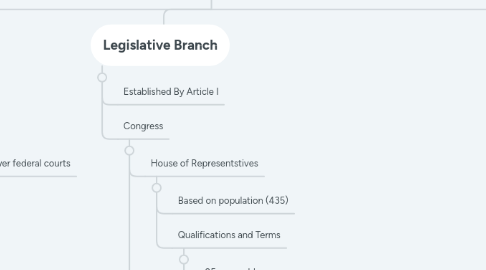
1. Executive Branch
1.1. Established by Article II
1.1.1. Grants the power to execute laws
1.2. President
1.2.1. Powers
1.2.1.1. Head of State
1.2.1.2. Chief Executive
1.2.1.3. Impoundment of Funds
1.2.1.4. Commander in Chief
1.2.1.5. Chief Diplomat
1.2.1.6. Legislative Leader
1.2.1.7. Economic Planner and Party Planner
1.2.2. Qualifications and Terms
1.2.2.1. Natural Born Citizen
1.2.2.2. Citizen for 14 years
1.2.2.3. 35 Years old
1.2.2.4. 2 four-year Terms (established by amendment 22)
1.2.2.5. Re-elected every 4 years
1.3. Vice President
1.3.1. Powers
1.3.1.1. Takes over in case the president is unable to perform his duties
1.3.1.2. Presides over the Senate, votes in the event of a tie
1.3.1.3. Decides if the president is capable of fulfilling his/her duties (alongside the cabinet)
1.3.1.4. Policy meetings, special assignments
1.3.1.5. Foreign policy efforts
1.3.2. Qualifications and Terms
1.3.2.1. Usually the same party as the President
1.3.2.2. Same legal requirements as the president
1.3.2.3. Serves four-year terms and are chosen by party leaders to run for re-election
1.4. Executive Departments
1.4.1. 15 departments, headed by Secretaries
1.4.1.1. Department of State
1.4.1.2. Department of Treasury
1.4.1.3. Department of Defense
1.4.1.4. Department of Justice
1.4.1.5. Department of the Interior
1.4.1.6. Department of Agriculture
1.4.1.7. Department of Commerce
1.4.1.8. Department of Labor
1.4.1.9. Department of Health and Human Resources
1.4.1.10. Department of Housing and Urban Development
1.4.1.11. Department of Transportation
1.4.1.12. Department of Transportation
1.4.1.13. Department of Education
1.4.1.14. Department of Energy
1.4.1.15. Department of Energy
1.4.1.16. Department of Veteran’s Affairs
1.4.1.17. Department of Homeland Security
2. Legislative Branch
2.1. Established By Article I
2.2. Congress
2.2.1. House of Representstives
2.2.1.1. Based on population (435)
2.2.1.2. Qualifications and Terms
2.2.1.2.1. 25 years old
2.2.1.2.2. Citizen of the US for 7 years
2.2.1.2.3. Resident of district you represent
2.2.1.2.4. Serve for 2 years
2.2.1.2.5. Elections held every 2 years in November
2.2.2. Senate
2.2.2.1. 2 Senators per state (100 total)
2.2.2.2. Qualifications and Terms
2.2.2.2.1. 30 years old
2.2.2.2.2. US citizen for 9 years
2.2.2.2.3. Live in state you represent
2.2.2.2.4. 6 year terms, 1/3 re-elected every 2 years
2.2.2.2.5. If there is a vacancy, state governor appoints
2.2.3. Powers
2.2.3.1. Enumerated Powers
2.2.3.1.1. Powers listed in Article I
2.2.3.1.2. Levy taxes, borrow money, coin money, declare war
2.2.3.2. Implied Powers
2.2.3.2.1. Established by the Necessary and Proper Clause
2.2.3.2.2. Grants congress the ability to elongate its powers to fit modern needs
2.2.3.2.3. NASA, Creation of the IRS, Setting a minimum wage
2.2.3.3. Bicameral, responsible for creating and passing laws
3. Judicial Branch
3.1. Established by Article III
3.1.1. Defines Court Jurisdiction
3.1.2. Grants Congress the power to create lower federal courts
3.2. US Supreme Court
3.2.1. Court Justices
3.2.1.1. Maximum of 9 at a single time
3.2.1.2. No explicit legal requirements to be appointed
3.2.1.3. Appointed by the President
3.2.1.4. Approved by the Senate
3.2.1.5. Serve until death, retirement, or removal for misconduct
3.2.2. Chief Justice
3.2.2.1. Appointed to preside over public court sessions and private discussions
3.2.3. Powers
3.2.3.1. Highest court in the land
3.2.3.2. Judicial review
3.2.3.3. Can appeal cases from lower courts
